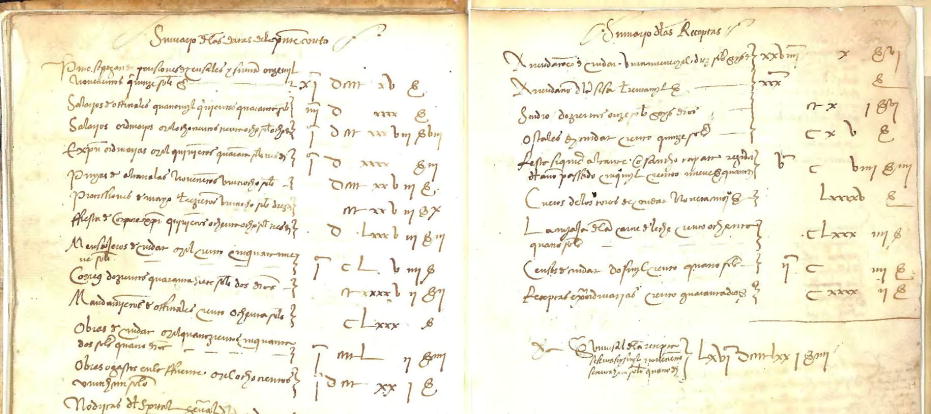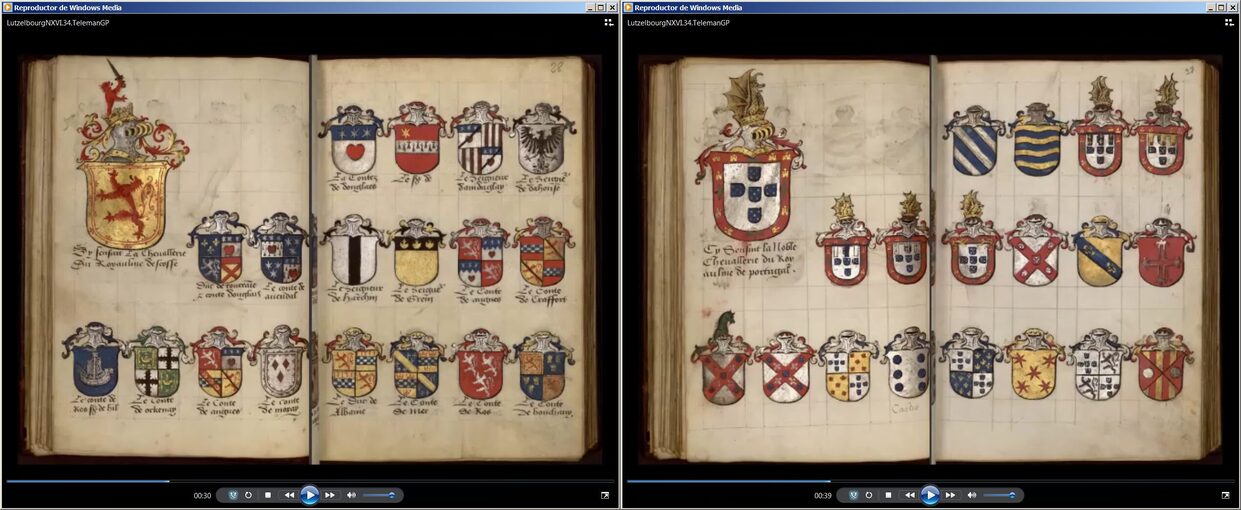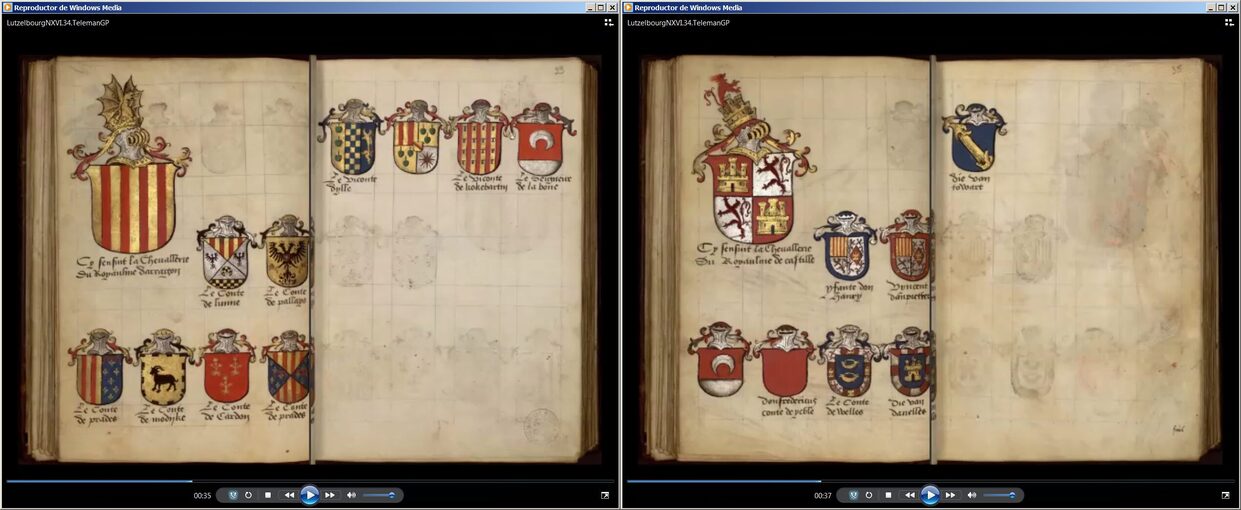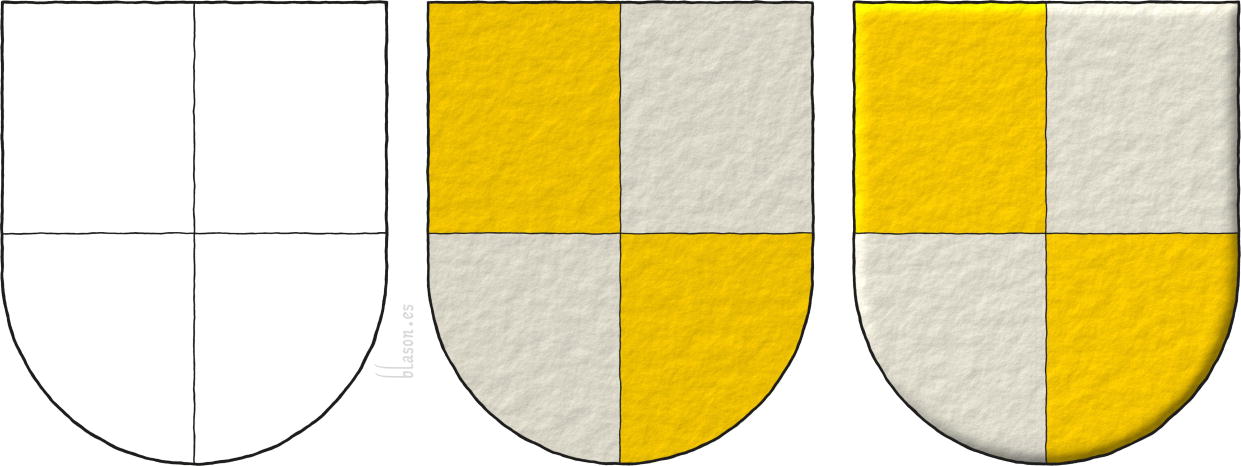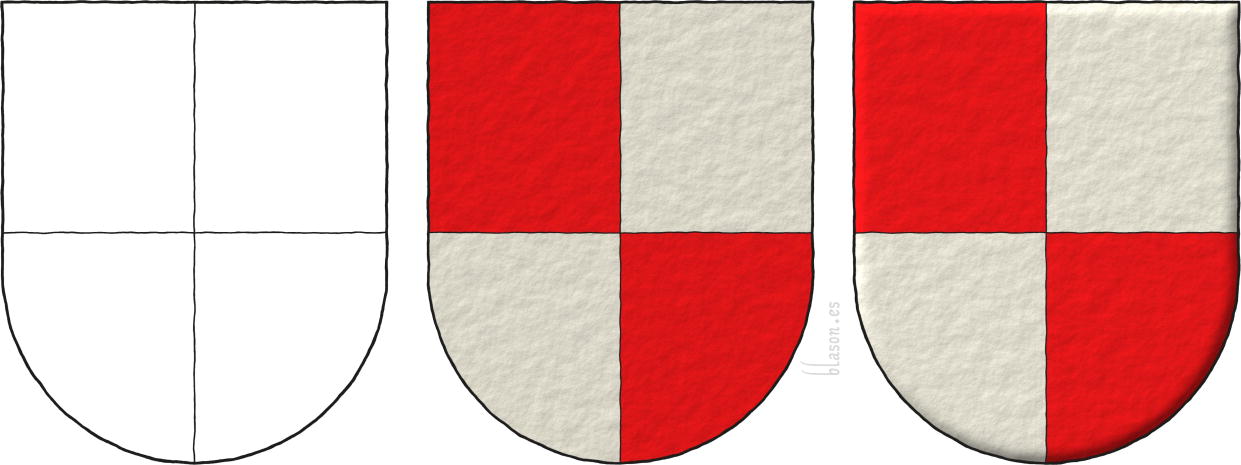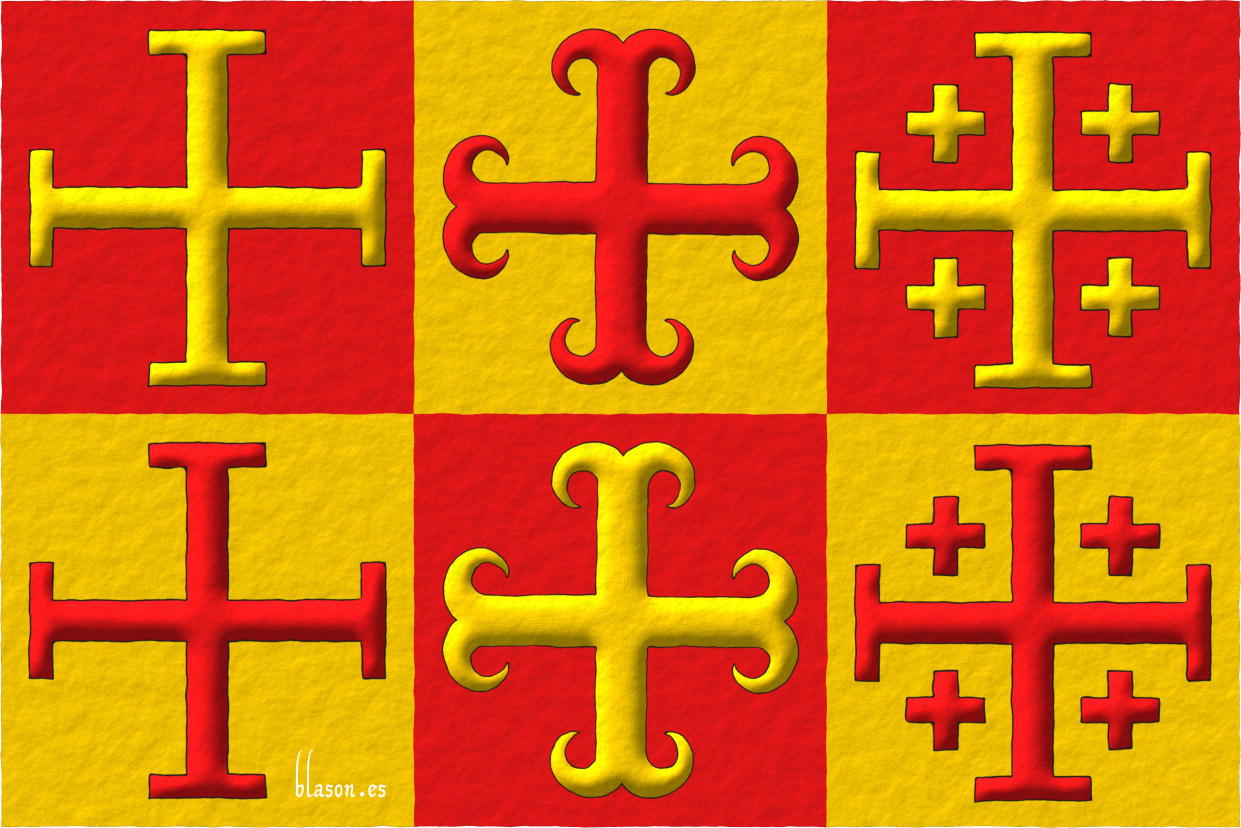
Vidriales, M. P.
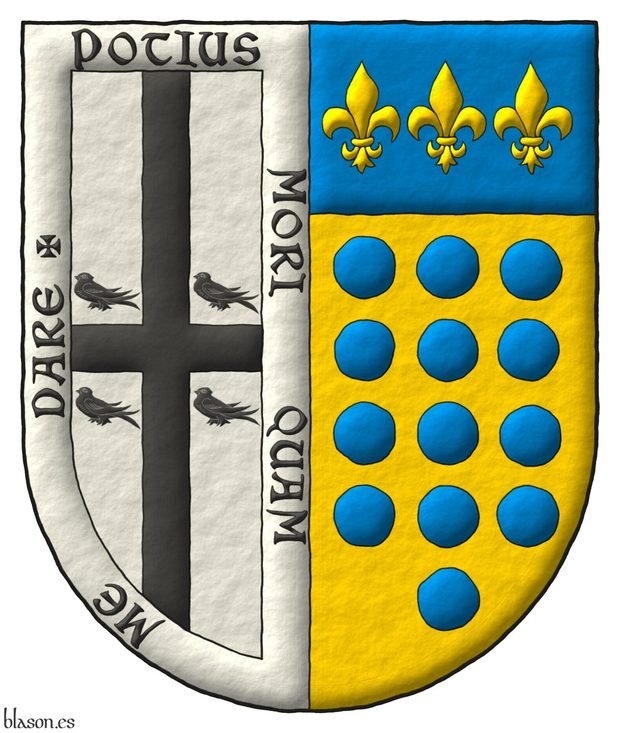
Interpreted coat of arms: with a semi-circular shape; illuminated with metals argent and or and colors sable and azure; outlined with sable; and a freehand finish.
Blazon keywords: Party per pale, Argent, Cross, Sable, Bordure, Motto, Or, Thirteen, Hurt, Hurt, torteau, pellet, pomme and golpe, Azure, Three, In pale, Four, Five, Chief, Fleur de lis, Cantoned and Martlet.
Style keywords: Freehand, Semi-circular, Illuminated and Outlined in sable.
Classification: Coat of arms, Interpreted and Personal.
Bearer: Vidriales, M. P..


![Ver [Selvester, G. W.; 2005] en referencias bibliográficas. Libro abierto, hojas de plata, filo de oro, guardas de gules, tapas de sable.](../css/Libro.Bibliografia.png)
Selvester, G. W.; 2005
Guy W. Selvester, Rev’d. Fr., M.Div., M.A., «Aspects of Heraldry in the Catholic Church», Summary of a presentation made on Wednesday, 14 September 2005, at the New York Genealogical & Biographical Society, New York, 2005.
Bibliographical reference of century XXI.
Classification: Article, English language and In color.
The author is Selvester, Guy W..
Internal resources: SelvesterGW2005.CatholicHeraldry.pdf PDF Format.


![Ver [Calvo, P.; 1501] en referencias bibliográficas. Libro abierto, hojas de plata, filo de oro, guardas de gules, tapas de sable.](../css/Libro.Bibliografia.png)
Calvo, P.; 1501
Pedro Calvo, notary and alderman of the city of Calatayud, «Libro de cuentas de la ciudad de Calatayud» ~ «Account book of the city of Calatayud», literal title, «Libro dela data fecha por pedro calvo notao Regidor dela ciutat de Calatayut enel anyo de mil Quinientos y uno», manuscript restored with cover, back cover and Mudejar style binding, 2 blank pages behind the cover and the back cover, 76 inner pages of 300 x 230 mm, of which 7 could be in white and in even position, 3 in white among the first 20 pages, 1 blank towards the middle of the book and another 3 blank between the last 20 pages, final annotation with the term «cabreo», Calatayud, 1501.
Bibliographical reference of century XVI.
Classification: Manuscript, In black and white and Castilian language.
Author: Calvo, Pedro.
External links:
- Documents and archives of Aragon, DARA Medieval, registry of the book and link to the image included here.
- Name of the Latin written after the fall of the Roman Empire and during the Middle Ages.
Internal resources: CalvoP1501.CalatayudDataOriginal.pdf book as a sequence of available pages and CalvoP1501.CalatayudDataPaginado.pdf book recomposed in sequence of odd and even pages, with blank pages inserted to recover lost sequences.


![Ver [Lutzelbourg, N. de; 1530] en referencias bibliográficas. Libro abierto, hojas de plata, filo de oro, guardas de gules, tapas de sable.](../css/Libro.Bibliografia.png)
Lutzelbourg, N. de; 1530
Nicolas de Lutzelbourg, lord of Fléville and captain of Nancy, «Roll of arms», sixteenth century (the author lived between 1485? and 1547), manuscript in French on parchment, with 230 pages numbered later with pencil the odd pages from 1 to 115, 29 x 21 cm, Bibliothèque-Médiathèque of Nancy digitized, source of the images with open license.
Video of 120 seconds composed for the Biblioteca Genealógica, Heráldica y Nobiliaria. Music by Georg Philipp Telemann (1681, 1767), Concerto for 4 Violins No. 2, TWV 40: 202, II. Grave, interpreted by Viola Viva, with Creative Commons license of Attribution and ShareAlike.
Content examples: Scotland on pages 28, 29 and 30 with 61 coat of arms; Aragon on page 33 with 11 coat of arms; Castile and Leon on page 35 with 8 coat of arms; Navarre on page 36 with 1 coat of arms; and Portugal on pages 37 and 38 with 27 coat of arms.
Bibliographical reference of century XVI.
Classification: Manuscript, Armorial roll, French language and In color.
Author: Lutzelbourg, Nicolas de.
Bibliographic reference mentioned in the following articles:
External resources:
- Manuscript's record in the Bibliothèque-Médiathèque of Nancy.
- Manuscript's pages in the Bibliothèque-Médiathèque of Nancy.


Quarterly Or and Argent and quarterly Gules and Argent, comparison
The rule of tincture, «metal should not be put on metal, nor color on color», is the most famous rule of the heraldry. In the divisions of the field, for example, party per fess, party per pale, quartered, etc., the tinctures are beside each other, not one on top of the other, because the divisions are not charges, so the rule of tincture does not apply. Although as a rule of aesthetics may be useful in the case of divisions.
Blazon keywords: Quarterly, Argent, Gules and Or.
Style keywords: Freehand, Outlined in sable, Plain tincture and Illuminated.
Classification: Schema.


Cross potent, cross moline, and cross of Jerusalem, comparison
A Gules and Or comparison between cross potent, cross moline, and cross of Jerusalem
Blazon keywords: Gules, Or, Cross potent, Cross couped, Cross moline, Cross of Jerusalem and Cross.
Style keywords: Freehand, Outlined in sable and Illuminated.
Classification: Schema.


![Ver [Stock, E.; 1895] en referencias bibliográficas. Libro abierto, hojas de plata, filo de oro, guardas de gules, tapas de sable.](../css/Libro.Bibliografia.png)
Stock, E.; 1895
Elliot Stock, «The Antiquary, A Magazine Devoted to the Study of the Past», Volume XXXI, Published by Elliot Stock, London, 1895.
Glossary of Terms used in British Heraldry
«The late Mr. John Henry Parker's name is so closely associated with quite a small library of admirable manuals on architecture, and with a number of other works on archaeology, all of which are well known, that it will be something of a surprise to many persons to learn that about fifty years ago», 1895 - 1847 = 48 years, «he published» [Parker, J. H.; 1847; Glossary of Terms used in British Heraldry].
«The book, too, has been out of print so long that it has become almost forgotten».
Glossary of Terms used in Heraldry, a new book
«The new edition now published by his son, Mr. James Parker», [Parker, J.; 1894; Glossary of Terms used in Heraldry], «is practically, as he himself tells us, a new book, and the elaboration and care which have been bestowed upon it are as characteristic of this as they are of the other archaeological works, for which both father and son have been so honourably distinguished for more than half a century».
Illustrations
«Another well-known characteristic of the Messrs. Parker's books is the copious manner in which they are illustrated».
«The present volume fully maintains that reputation, and the neat little woodcuts, which occur in great profusion on nearly every other page, are often a great help in explaining in a practical manner the significance of a heraldic term».
«To anyone who is beginning the study of heraldry this will render the book of great value and usefulness; while others who know more or less of the science will not be disposed to regret the lavish manner in which explanatory illustrations are provided».
Critic, Chichester and Prester John
«So far as it is possible to judge there are very few, if any, inaccuracies in the book, although we are bound to express surprise in finding in such a work as this, the old fiction repeated, that the figure of our Saviour, in relation to the dedication of the cathedral to the Holy Trinity, on the arms of the See of Chichester is that of the mysterious being known as Prester John».
«We thought this absurd theory had been fully exploded long ago, and to find it perpetuated in a work like this is a little startling, to say the least».
The 3 main references in James Parker's book to Prester John the See of Chichester are the following:
- About the Presbyter John, usually called Prester John: «this singular figure is represented as seated on a stone (described as a tombstone), and forms the insignia of the See of Chichester, the only instance in which the bearing occurs», [Parker, J.; 1894; page 476]. «The origin of the figure is obscure». «In 1180 the seal represented the Figure of Christ seated on a Tomb, with perhaps a symbolical reference to» the Book of Revelation i. 16, and v. 1, also called the Apocalypse of John the Apostle. «Early in the next century the mythical story of Prester John, a supposed King of central Asia, was current, a certain Franciscan monk, by name Carpini, who went out as a Missionary in 1206, having brought home or invented the story, and this being very popular was afterwards, perhaps, applied to the device».
- About the blazon of the Bishopric of Chichester, he writes «Bishoprick»: «Azure, a Presbyter John hooded sitting on a tombstone, in his sinister hand a book open, his dexter hand extended with the two forefingers erect, all or; in his mouth a sword fessways gules, hilt and pommel or, the point to the sinister», [Parker, J.; 1894; at the end of the page 476].
- About «tombstone» as an heraldic term, [Parker, J.; 1894; page 576] writes: «the seat of Prester John (q.v.)» ~ quod vide ~ which see «in the insignia of the See of Chichester, and of Saint Mary in those of the See of Lincoln», see also the term nimbus or «Cicle of Glory» at [Parker, J.; 1894; page 424], «is so called, though in neither case is it at all probable that the bearing is intended for such».
«It would be an interesting fact to ascertain exactly when and by whom», Elliot Stock asks himself, «the very wild idea of Prester John on the Chichester shield was first started».
Nowadays, the Diocese of Chichester, in its on-line explanation about its coat of arms, writes «The most common misconception, which was still being repeated in 1894», the Diocese does not cite directly James Parker's book, but cites its publishing year 1894, «was that the arms show Presbyter John sitting on a tombstone». «A letter circulated in Europe in about 1165 referred to the annual visit of Prester John and his army, complete with chariots and elephants, to the tomb of the prophet Daniel in Babylonia Deserta». «It was the imagery of this letter», about the Prester John and the tomb, «that seems to have become attached to» the coat of arms of the Diocese of Chichester with its human figure, nimbed, sitting in a tomb or an altar.
Conclusions
«As showing the thoroughness with which Mr. James Parker has done his work, we may mention that»:
- «no less than 32 pages are taken up in describing the different heraldic forms and uses of the cross», [Parker, J.; 1894; from the page 149 to the beginning of the page 179] and with an internal index, dedicated exclusively to the cross, on [Parker, J.; 1894; pages 179 and 180].
- «and 8 with the various forms of the crown», [Parker, J.; 1894; from the page 181 to the page 188].
«In every instance the subject dealt with is thoroughly worked out».
«Indeed, thoroughness may be said to be one of the special characteristics of this useful and welcome volume».
Elliot Stock, the reviewer
He was an English publisher and bibliophile, he born in 1838 and died in 1911. The publishing company that bore his name was in business from 1859 to 1939. The Antiquary magazine was published by his publishing company from December 1879 to 1915.
Bibliographical reference of century XIX.
Classification: Magazine and English language.
The author is Stock, Elliot.
Bibliographic reference mentioned in the following articles:
External links:
- The Antiquary, Volume XXXI, datails.
- The Antiquary, Volume XXXI, contents.
- Elliot Stock, publisher of the The Antiquary.
- Chichester, Coat of arms of the Diocese.


Vittorio Gifra
![Arma: palato d’azzurro e d’oro di sei pezzi, alla banda del primo [azzurro] attraversante sul tutto. Paly of six Azure and Or; over all a bend Azure.](../escudo_armas/GifraV.20.MedioPunto.Pergamino.jpg)
Arma: palato d’azzurro e d’oro di sei pezzi, alla banda del primo [azzurro] attraversante sul tutto.
Paly of six Azure and Or; over all a bend Azure.
Blazon keywords: Paly, Six, Azure, Or, Surmounted, Overall (deprecated) and Bend.
Style keywords: Semi-circular, Parchment, Plain tincture and Outlined in sable.
Classification: Coat of arms, Interpreted and Personal.
Bearer: Gifra, Vittorio.

Continue with: Gifra, Vittorio.
-
Language
-
Categories of heraldry
-
Divisions of the field
- Without divisions
- Party per pale
- Party per fess
- Party per bend
- Party per bend sinister
- Tierce
- Tierce sinister
- Tierced per fess
- Tierced per bend
- Tierced pallwise inverted
- Quarterly
- Quarterly per saltire
- Gyronny
- Party per fess, the chief per pale
- Party per pale, the sinister per fess
- Party per fess, the base per pale
- Party per pale, the dexter per fess
- Chapé
- Chaussé
- Party per chevron
- Enté en point
- Flanched
-
Metals
-
Colours
-
Furs
-
Other tinctures
-
Ordinaries and sub-ordinaries
-
Diminutives of the ordinaries
-
Other charges
-
Charges from Nature
Water, Eagle, Bald eagle, Eagle claw, Dorsal fin, Tail fin, Two hands clasped, Lark, Tree, Trunk, Rainbow, Atom, Barbel, Acorn, Bighorn sheep, Arm, Owl, Vulture, Horse, Head, Goat, Camellia, Thistle, Merino ram, Kapok tree, Stag, Doe, Crescent, Increscent, Chrysanthemum, Tail, Tail addorsed, Ermine spot, Hummingbird, Snowflake, Heart, Roe deer, Neck, Roe deers' attires, Raven, Dolphin, Diamond, Tooth, Elephant, Emerald, Starling, Mullet, Mullet of four points, Star of David, Estoile, Male figure, Fleur de lis, Flower, Cornflower, Dogwood flower, Lotus flower, Hop cone, Bluebonnet, Puffin, Ash, Rooster, Claw, Talon, Goose, Heron, Seagull, Pomegranate, Sunflower, Swallow-tail, Falcon, Leaf, Boar, Goldfinch, Laurel, Barn owl, Lion, Lioness, Lion passant, Leopard, Lion rampant guardant, Lynx, Lily, Madonna lily, Flame, Wolf, She-wolf, Parrot, Moon, Hand, Apple, Apple tree, Sea, Martlet, Wing, Two wings in vol, Covert, Blackbird, Mount, Trimount, Fly, Wrist, Elm, Olive tree, Orbital, Bear, Palm frond, Palm tree, Dove, Poplar leaf, Panther, Jaguar, Vine, Paw, Forepaw, Foot (palmiped), Foreleg, Peacock, Chest, Pelican, Pelican in her piety, Dog, Brach hound, Warren hound, Fish, Hoof, Beak, Quill, Cinquefoil, Quetzal, Branch, Sprig, Frog, Shamrock, Caboshed, Oak, Holm oak, Rose, Double rose, Savage, Serpent, Plough of Ursa Major, Sun, Sun in splendour, Ray of the sun, Lightning flash, River, Stem, Badger, Tyger, Linden, Wheat, Wheat spike, Bull, Tulip, Udder, Escallop and Fox.
-
Artificial charges
Halberd, Plough share, Ace of spades, Anchor, Cyclamor, Torch, Bow, Arch, Harp, Non-classic artifact, Winnowing fan, Crozier, Conductor's baton, Pair of scales, Ship, Oar, Sail, Norman ship, Beret, Grenade, Ecclesiastical cap, Arm vambraced, Knight, Chain, Covered cup, Monstrance, Bell, Bell tower, Cannon dismounted, Carbuncle, Castle, Ribbon, Clarion, Nail, Cord, Dagger, Key ward, Turret, With a turret, Armillary sphere, Sword, Federschwert, Sabre, Parchment, Scroll, Arrow, Club, Garb, Sheaf of tobacco, Scythe, Gauntlet, Axe, Buckle, Galician granary, Polish winged hussar, Church, Oil lamp, Spear, Spear's head, Fleam, Letter, Book, Open book, Closed book, Bookmark, Page, Line, Lantern, Key, Four crescents joined millsailwise, Hammer, Menorah, Mortar, Pestle, Number, Knot, Celtic Trinity knot, Water-bouget, Comb, Piano, Millstone, Millrind, Millwheel, Clay pot, Bridge, Cuffed, Hourglass, Chess rooks, Compass rose, Rosette of acanthus leaves, Mullet of six points pierced, Broken, Portcullis, Wheel, Wagon-wheel, Symbol, Sackbut, Drum, Geometric solid, Tetrahedron, Tower, Trident, Trumpet, Double vajra and Anvil.
-
Immaterial charges
Angel, Archangel, Basilisk, Heart enflamed, Sacred Heart of Jesus, Paschal lamb, Dragon, Wyvern, Phoenix, Garuda, Griffin, Sea-griffin, Winged hand, Our Lady of Mercy, Pegasus, Saint George, Mermaid, Trinity, Triton, Golden fleece, Unicorn and Ouroboros.
-
External elements
-
Heraldic creations
-
References
-
Formats
-
Keywords on this page
Parchment, Armorial roll, Article, Azure, Bend, Bibliography, Bordure, Surmounted, Cantoned, Five, Cross, Cross moline, Cross of Jerusalem, Cross potent, Cross couped, Quarterly, Four, Outlined in sable, In black and white, In color, In pale, Coat of arms, Schema, Fleur de lis, Personal, Gifra, Vittorio, Gules, Illuminated, Interpreted, Chief, Motto, Castilian language, French language, English language, Manuscript, Martlet, Semi-circular, Or, Paly, Party per pale, Argent, Magazine, Hurt, torteau, pellet, pomme and golpe, Hurt, Six, Century XVI, Overall (deprecated), Plain tincture and Freehand.
